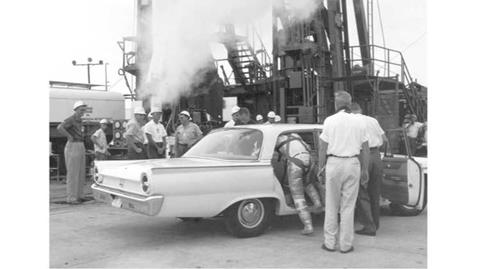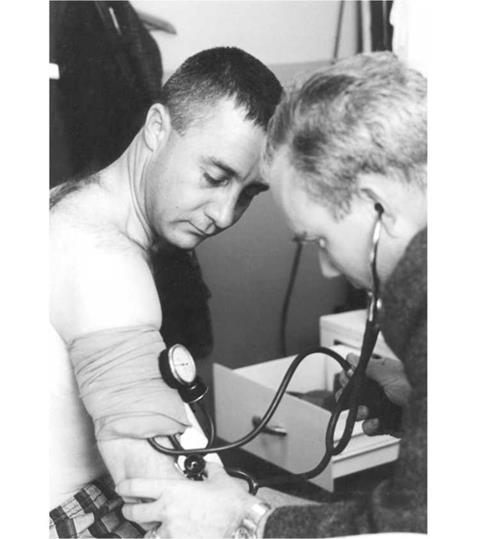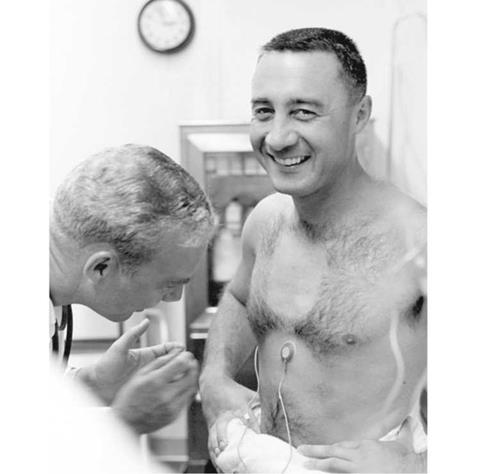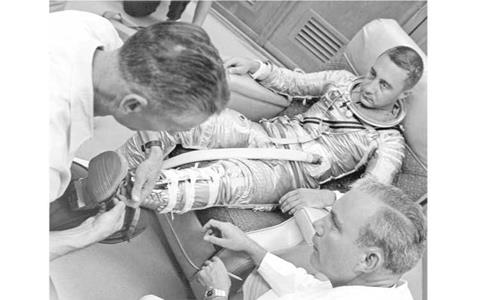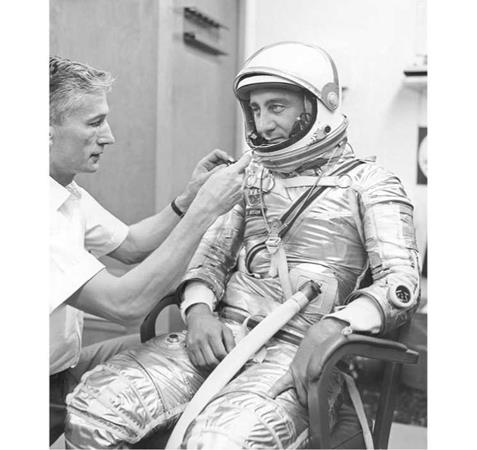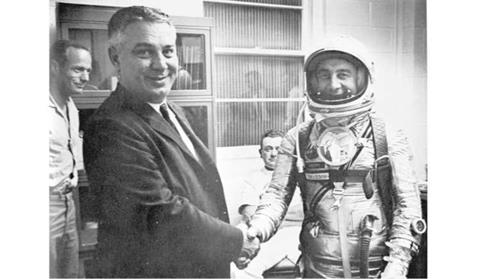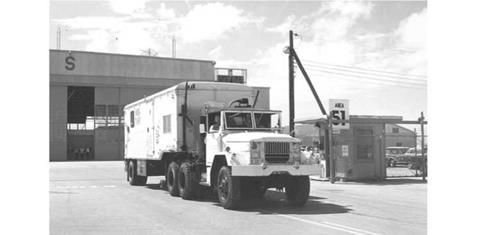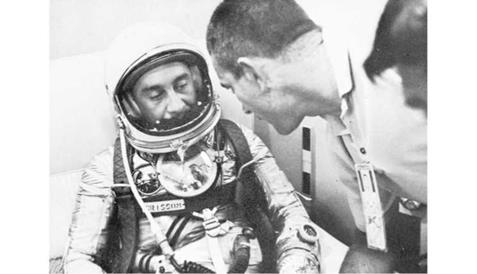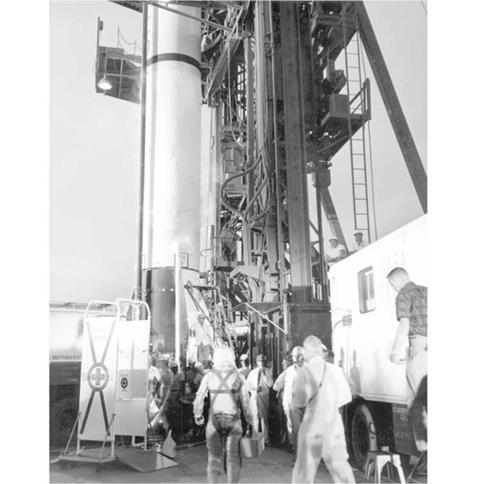SECOND ATTEMPT
The weather at Cape Canaveral on Tuesday morning was overcast but the engineers and scientists once again busied themselves preparing the Redstone. By this time the beaches and nearby roads were lined with hundreds of tourists anxiously waiting for the launch spectacle. Grissom and Glenn took advantage of the postponement to get in a little running and to study a map of geographical features that Grissom might be able to see while looking down on Earth from an altitude of 115 miles. Grissom then grabbed a fishing pole, strode to the beach and caught a four-pound bass – which he threw back. Afterwards he returned to the business of getting ready for his flight the next day.
Confident that the weather would be fine by launch time, NASA decided Tuesday night to go ahead with plans to send Grissom into space the next morning. Informed sources said rain squalls which had drenched the rocket firing center late in the day would move to the north by early morning, clearing the skies.
Grissom said he watched an episode of The Life and Legend of Wyatt Earp on television that evening before going to bed at nine o’clock.
“I slept like a brick for four hours and woke up wondering what time it was and what the weather was like. Just then Bill Douglas came in and sat down on the bed. He just sat there for a few moments, but when he saw me looking at him he said simply, ‘Well, get up.’”21
After being told the one remaining weather hazard was an area of rain moving across the Gulf of Mexico, which the weather people expected would break up on the west coast of Florida, Grissom was told that the count had been pushed ahead by an hour to try and beat the weather. The launch was now provisionally set for 7:00 a. m.
“The schedule allotted me 30 minutes for breakfast, another 30 minutes for a short physical [examination], 10 minutes to fasten on the electronic sensors which would report my pulse, temperature and breathing rate back to the Control Center, 30 minutes to put on my pressure suit, then 30 minutes to get into the van and ride out to the pad.”22
Apparently someone forgot to pass on word about the earlier launch time to the cook, as breakfast was not ready at 1:45 a. m. as intended under the revised schedule. A decision was made to conduct the physical exam first, and then tackle breakfast. Grissom donned his bathrobe and entered the medical room where Bill Douglas was waiting. As he subsequently recalled, there was nothing unusual about the preflight examination except that Douglas was concerned about the astronaut’s blood pressure count.
“It can’t be this low,” he said over and over again. Grissom, calm and composed, suggested with a laugh that he could boost it up a bit for the records if he wanted, but Douglas remained amazed at the unexpectedly low reading.
“I think you ought to be just a little bit excited,” he said with a smile and a shake of his head. Next, Grissom had a short session with NASA’s consultant psychiatrist George Ruff, who wanted to explore the astronaut’s thoughts.
“He made me recite my feelings, and then we played some little games with words and numbers – to make sure I was completely sane, I guess.”23
Grissom asked that his wife, Betty, and other members of his family be advised by telephone of the advance in the launch schedule. Breakfast was then shared with Glenn and Scott Carpenter, along with NASA Operations Director Walt Williams, following which Grissom had biomedical sensors attached to his body. To ensure that these were correctly positioned, Grissom (like the other astronauts) had a two-millimeter-diameter tattooed dot at each of the four electrode sites. Then he suited up with the assistance of suit technician Joe Schmitt, and was ready for a pressure check of the suit at 3:10 a. m. Once this had been completed, Grissom boarded the big white transfer van outside Hangar S at 4:15 for the ride over to Launch Pad 5.
|
Dr. William Douglas takes Grissom’s blood pressure. (Photo: NASA) |
At the pad, everyone remained inside the air-conditioned vehicle as Grissom waited for word to step out and make his way to the gantry elevator. At one stage Deke Slayton entered the van to give Grissom a final weather briefing, which was not all that positive because cirrus clouds were moving in and thickening as they approached the Cape. However the local weather reports suggested the skies might be clear enough at launch time to proceed. At 5:00 a. m., word arrived that Grissom could make his way over to the gantry elevator, for the ride up to the spacecraft on the third gantry level, some 65 feet above the ground. The skies were clear over the launch area.
|
Totally relaxed, Grissom laughs as the biomedical sensors are glued to his chest by Dr. Douglas. (Photo: NASA) |
“I stepped out of the van, took a quick look at the tall, white Redstone, and headed for the elevator,” Grissom later said. “Just then all the men working around the pad started to applaud. I must admit this choked me up a little. It was a darn fine feeling, as I looked down and saw them staring up at me, that I had all these people pulling for me.”24
On arrival at the third level Grissom walked across the gantry platform and at 5:38 a. m., after some preliminary procedures, he began to squeeze his 155-pound frame into the capsule with the assistance of John Glenn. Once inside, Joe Schmitt hooked him up to the capsule’s air and communications systems and strapped him tightly into the contour couch. After shaking hands with some of the gantry crew, Grissom started to thank Glenn, who unexpectedly handed him a note which read “Have a smooth apogee,
|
Bill Douglas looks on as suit technician Joe Schmitt laces Grissom’s boots. (Photo: NASA) |
|
Joe Schmitt prepares Grissom’s helmet. (Photo: NASA) |
|
Ready to board the transfer van, Grissom shakes hands with Operations Director Walt Williams as Scott Carpenter (left) looks on. (Photo: NASA) |
|
The NASA transfer van departs Hangar S for Launch Pad 5. (Photo: NASA) |
Gus, and do good work. See you at GBI [Grand Bahama Island].” Grissom laughed at the reference to his own brief motto delivered at the Convair plant, and after he had shaken Glenn’s hand the hatch was bolted in place. He was now alone inside Liberty
|
As Grissom waits at the pad in the transfer van, Deke Slayton gives him the latest weather forecast. (Photo: NASA) |
Bell 7, with very little do as he waited for the firing order. Noticing that his window was a little smeared with fingerprints from well-wishers who had pressed up against the glass, he reported this to Guenter Wendt and was assured that it would be wiped clean. One technician who happened to overhear this exchange joked with Grissom they would be sure to install windscreen wipers on the capsule before its next launch.
Eventually the gantry was withdrawn and the Redstone stood alone, poised for launch and pointed at the sky.
The countdown clicked along to within 10 minutes, 30 seconds of firing. Then NASA officials called a halt to study the weather situation. The ‘hold’ dragged on and the count was recycled to 30 minutes. Finally at 9:00 a. m., two hours after the scheduled time, the reluctant but necessary decision was made to postpone the shot because the heavy, high-level cloud cover was too dense to permit camera coverage of the first critical moments of rocket flight and photographic tracking of the rocket. The launch was rescheduled for 6:00 a. m., Friday. A bad guess on the weather had led to the scrub. A two-day postponement was required because the Redstone had to be purged of its fuels, dried out, cleaned, and checked for contamination.
Grissom had sweated out 3 hours, 57 minutes in the cramped capsule, but as he climbed out was still able to muster a weak smile. “I was disappointed, however, after spending four hours in the couch. And I did not look forward to spending another 48 hours on the Cape.
“But I felt sure we would get it off the next time around. And we did.”25
|
|
|
